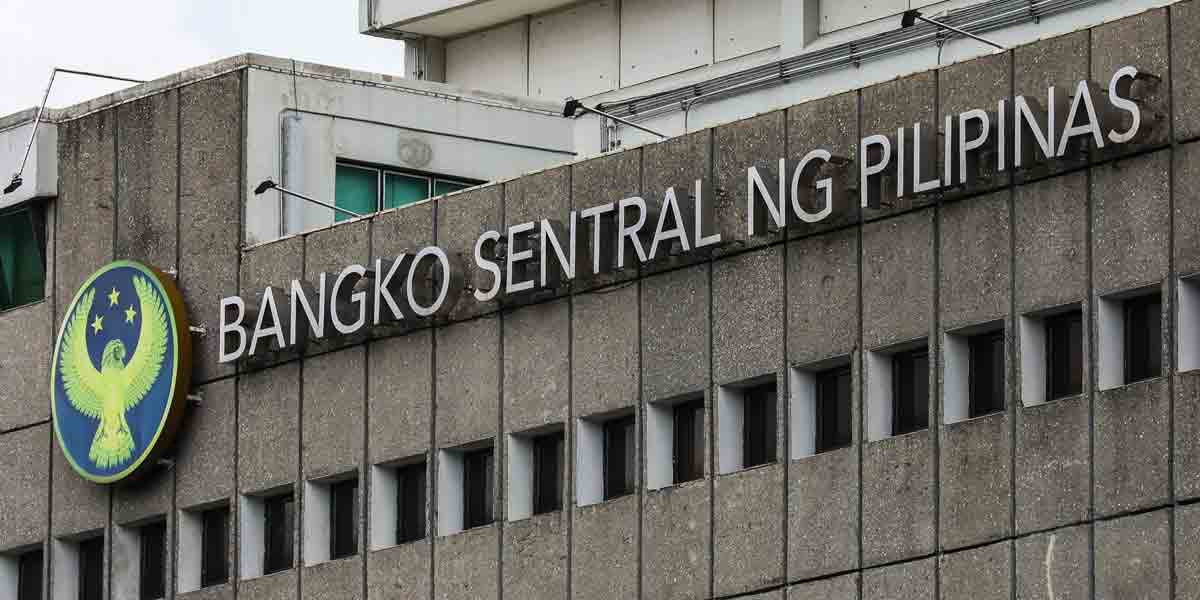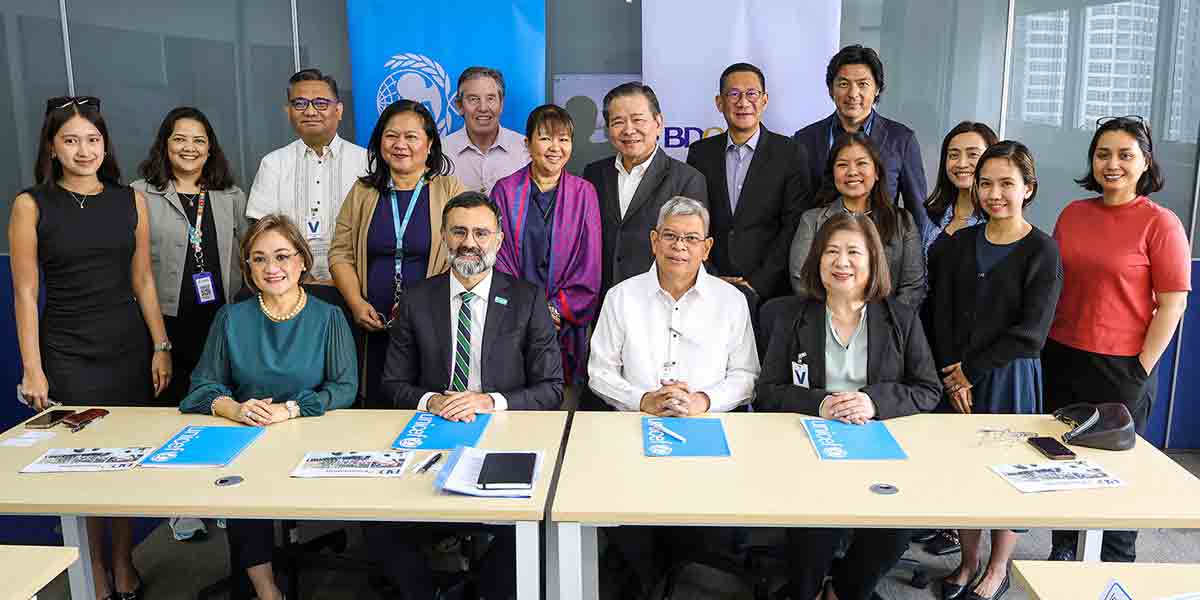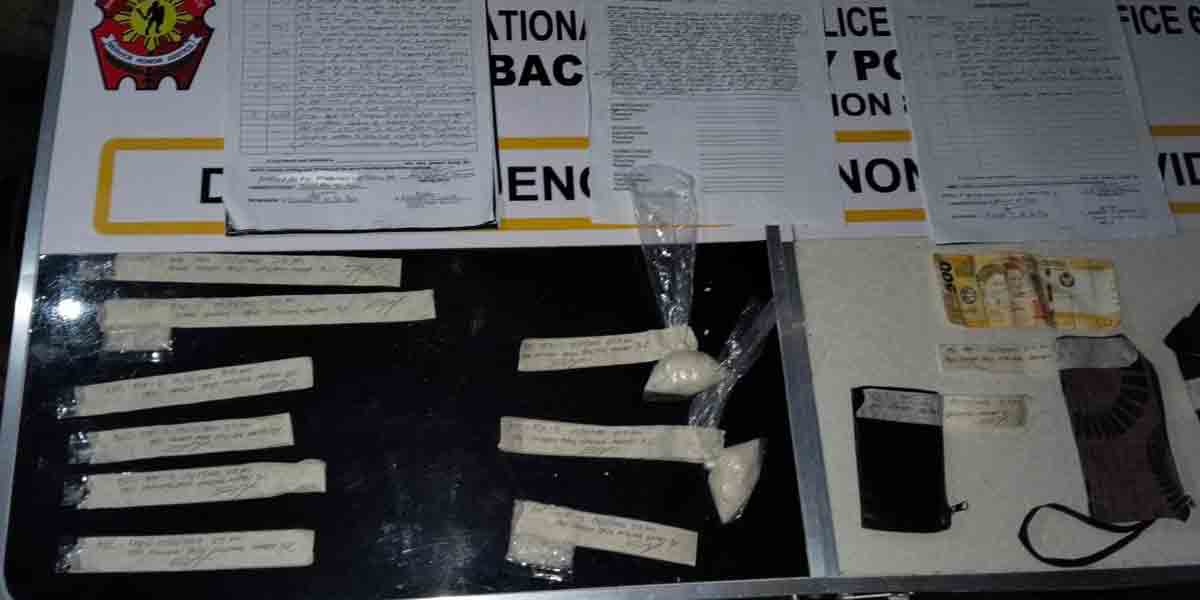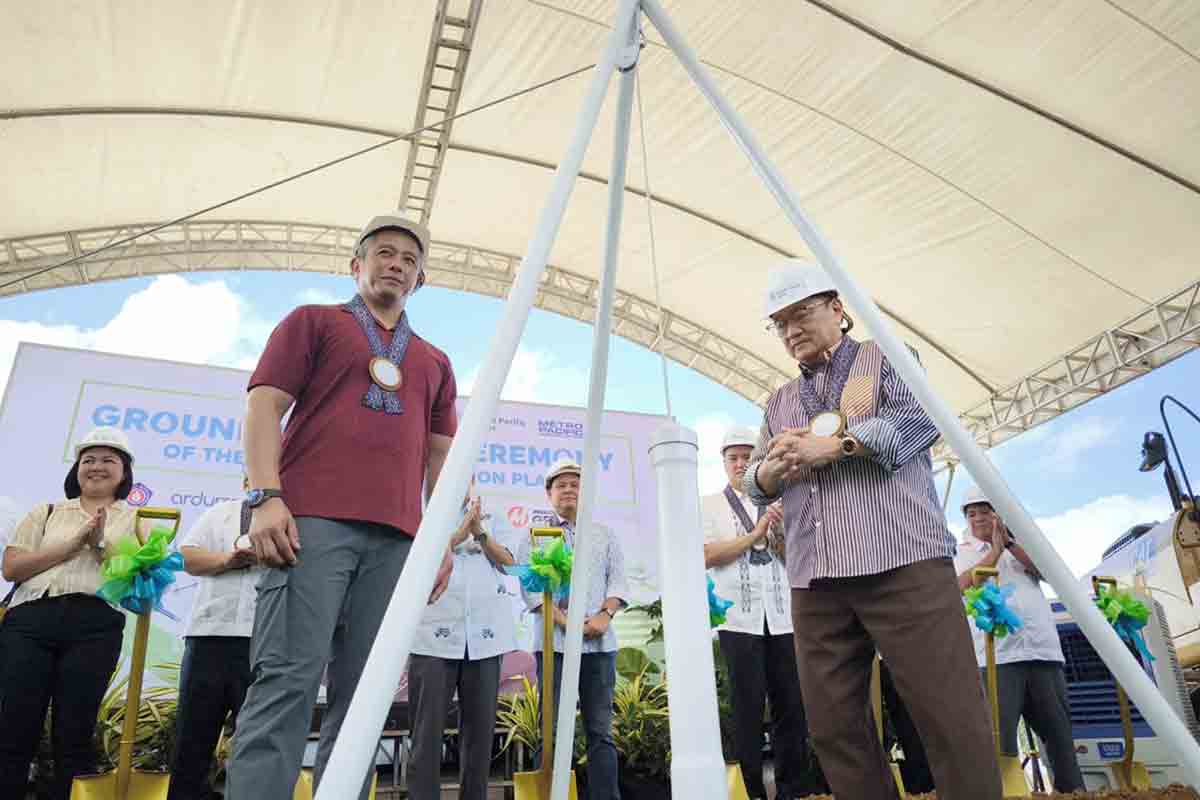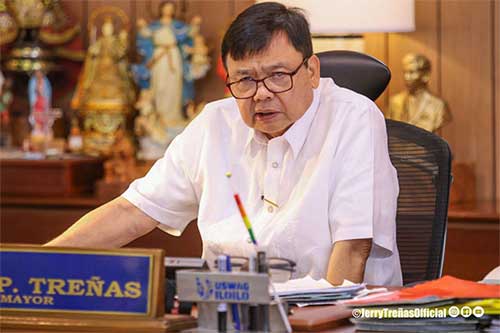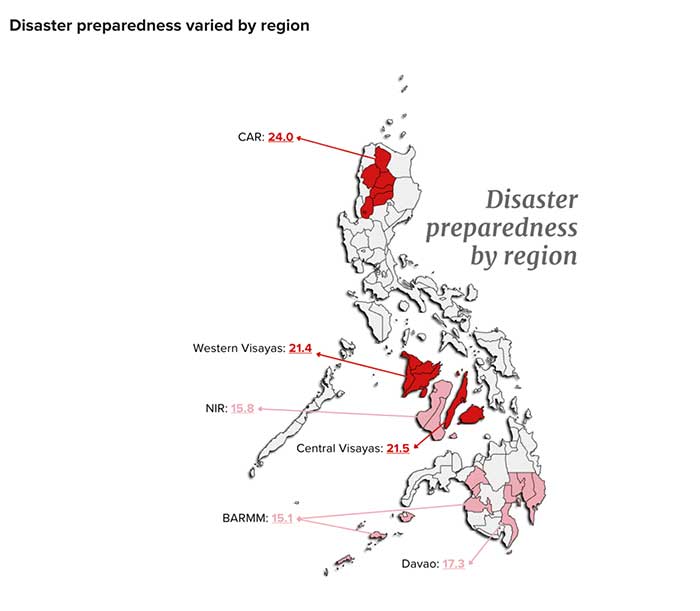
By Francis Allan L. Angelo and Joseph Bernard A. Marzan
Western Visayas reported one of the highest levels of disaster preparedness in the Philippines, according to a new study conducted by the Harvard Humanitarian Initiative (HHI).
The survey, which took place from February to March 2024 and involved 4,608 respondents nationwide, showed that Region VI scored 21.4 out of 50, ranking third after the Cordillera Administrative Region (24.0) and Central Visayas (21.5).
The study, titled “Survey on Disaster Preparedness and Climate Change Perceptions,” revealed an average nationwide preparedness score of 19.2, a marked improvement from 13.5 in 2017.
Dr. Vincenzo Bollettino, director of the HHI Resilient Communities program and co-lead of the study, noted that while the increase represented progress, it was still insufficient given the Philippines’ status as the most disaster-prone country globally.
“A score of 19.2 highlights both progress and areas needing urgent attention. While it shows an improvement in disaster preparedness, the score suggests that Filipinos are only doing 38.4% of the necessary disaster preparedness activities,” Bollettino said.
“For a country as vulnerable to disasters as the Philippines, this is not enough, so we must accelerate our efforts to ensure Filipinos are investing, planning, training, and building closer ties to their communities,” he added.
Regional Variations in Preparedness
Western Visayas’ score of 21.4 positioned it among the most prepared regions, reflecting efforts in community engagement and proactive measures.
In contrast, the Davao Region (17.3), Negros Island (15.8), and the Bangsamoro Autonomous Region in Muslim Mindanao (BARMM) (15.1) ranked lowest.
Despite its low score, BARMM showed a significant 90% improvement from 2017, highlighting the region’s efforts to strengthen disaster readiness despite historical challenges related to conflict and limited infrastructure.
Surprisingly, the National Capital Region (NCR), considered the economic hub of the country, ranked 11th with a score of 19.1, just below the national average.
“NCR is the heart of the Philippine economy and home to a significant part of the country’s population, yet it is routinely hit by natural hazards; thus, increasing its disaster preparedness is crucial,” Bollettino remarked.
Key Preparedness Measures and Gaps
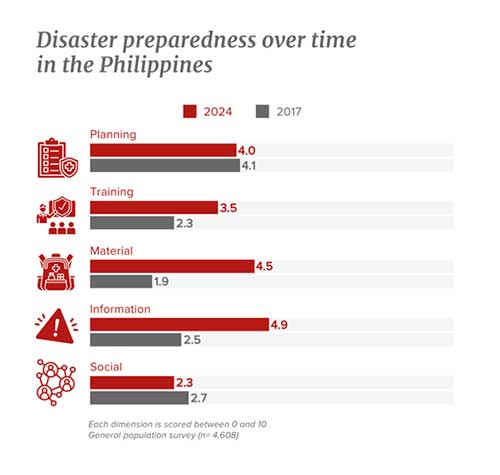
The survey assessed disaster preparedness based on five criteria: planning, training, material investments, information, and social support, each scored from 0 to 10.
Filipinos performed best in information-related activities, scoring 4.9, followed by material (4.5), planning (4.0), and training (3.5). But we struggled with social support, which received only 2.3.
The data showed that 87% of respondents took steps to safeguard important documents like birth certificates and property titles, and 70% regularly monitored typhoon and disaster warnings, followed by familiarization with the rainfall warning system (60 percent), discussion of emergency plans with family (58 percent), and retrofitting and strengthening their houses (55 percent).
The low scores were on knowing local disaster risk reduction and management officer (16 percent), having a disaster management plan (20 percent), becoming a member of a relevant group or association (23 percent), having adequate insurance (25 percent), and having a “Go Bag” or emergency kit (27 percent).
“While many Filipinos discuss emergency plans as a family (58%), fewer have taken concrete actions such as preparing emergency kits or participating in disaster drills,” the report noted. These findings underscore the gap between awareness and tangible action.
Low Material Investments And Social Support
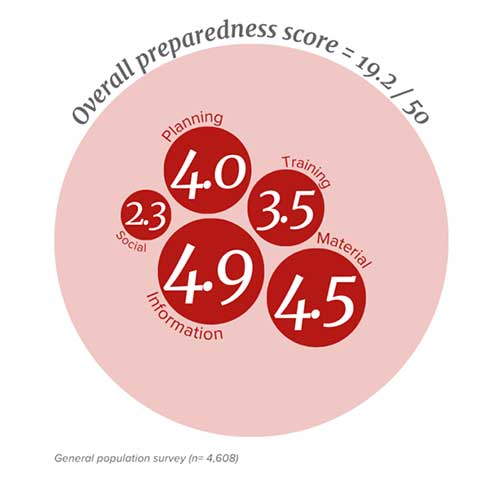
Among the objective measures of disaster preparedness, Filipinos scored highest in information (4.9 out of 10); and scored lowest in social support (2.3 out of 10). However, the overall score remains relatively low across all dimensions.
Survey participants were also asked what activities their households carried out to prepare for disasters.
In terms of specific social support activities, only a few Filipinos are members of a group or association (23%) and are familiar with their local disaster risk reduction and management officers (16%). Generally, social support declined from 2.7 out of 10 in 2017 to 2.3 in 2024.
Most Filipinos implemented measures to safeguard important documents like birth certificates and property titles (87%). Many Filipinos also monitor typhoon and other disaster warnings (70%) and familiarize themselves with rainfall warning systems (60%), suggesting they routinely experience water-related hazards, such as storms and floods.
While many Filipinos discuss emergency plans as a family (58%), only a few have prepared their respective disaster management plan (20%), Go bag (27%), adequate supplies of regularly taken medications (32%), and first-aid kit (33%).
Dr. Patrick Vinck, Director of Research at HHI, emphasized the need for additional material investments at the local level.
“Enhancing the Philippines’ disaster preparedness requires investing in local leadership and leveraging technology to improve early warning systems and community engagement, among other critical measures. This should be accompanied by investments in resilient infrastructures, local capacities, and anticipatory actions,” Vinck said.
Socioeconomic Factors Influencing Preparedness
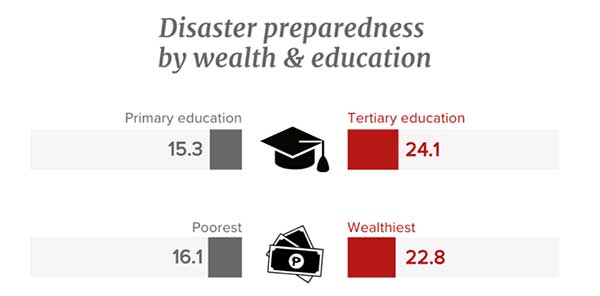
The survey also highlighted disparities in disaster preparedness based on socioeconomic factors. Filipinos with higher education levels reported better preparedness scores, with those who attended higher education scoring 24.1 compared to 15.3 for those with only primary education. Similarly, wealthier respondents reported higher levels of preparedness.
Path Forward for Resilience
The HHI emphasized that continued investments and targeted policies are vital for building a disaster-resilient nation.
With the Philippines ranked as the most disaster-prone country for three consecutive years now, increasing support and investments in preparedness are crucial.
It is essential for key decision-makers and policymakers to understand disaster preparedness and resilience through the lens of Filipinos themselves to align relevant programs and policies with emerging needs and priorities at the household level, Bollettino emphasized.
HHI’s 2024 nationwide survey collected data using a standardized questionnaire administered during face-to-face interviews by trained local enumerators.
Data was collected from 4,608 Filipinos across regions from February to March 2024, conducted through face-to-face interviews using a standard questionnaire.
The sample was designed to provide representative data at the regional level. Data were weighted to match the population distribution. This ensured that the findings reflect the perspectives of the broader population across the Philippines.
Besides disaster preparedness, the survey also explores climate change perceptions, mental health impacts, micro, small and medium enterprise (MSME) resilience, and disability-inclusive DRRM, among others.
The Philippines has the highest risk score in the world according to the WorldRiskReport, an annual technical report on global disaster risks jointly published by Institute for International Law of Peace and Armed Conflict (IFHV) of Ruhr University Bochum and Bündnis Entwicklung Hilft, both based in Germany.
The report indicated the Philippines’ index score of 46.91 as of 2024, based on metrics of exposure and vulnerability, the latter broken down further into three dimensions (susceptibility, coping, and adjustment).
The other four countries with the highest risk indexes include Indonesia (41.13), India (40.96), Colombia (37.81), and Mexico (35.93).








